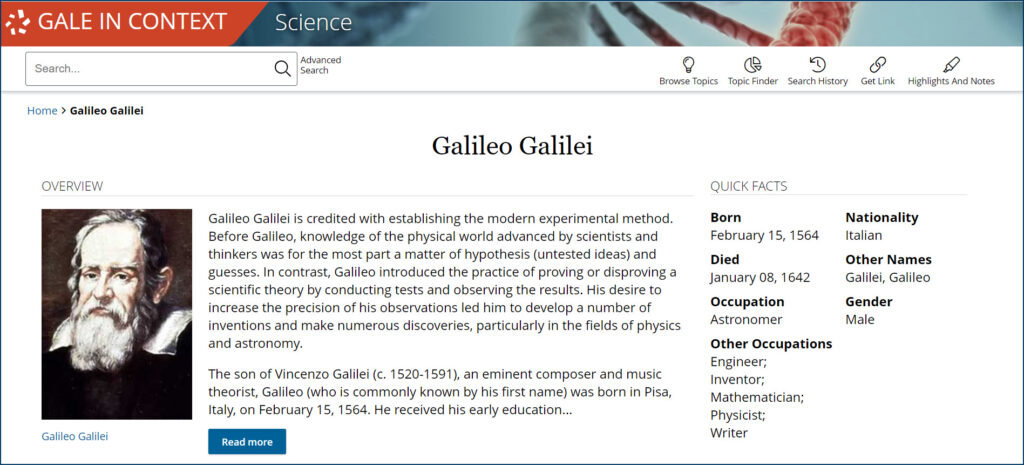| By Gale Staff |
Your middle schoolers are starting to explore more complicated scientific concepts. While elementary learners are curious about the world around them, young teens are ready to think critically and question the why behind our universe. As a science teacher, you nurture and guide that curiosity.
To create a strong foundation for the scientific field, why not investigate its history and key figures? One such character is Galileo Galilei, whose 460th birthday is February 15. Instead of a party (though you could always bring cake to celebrate), you can create a lesson plan analyzing Galileo’s life and the fascinating period in which he lived. This man took on Aristotle and won, in the process changing how people viewed the Earth’s orientation within the solar system. He and his peers redefined science.
To help you get started, direct your students to the Galileo portal in Gale In Context: Science. Users will find age-appropriate, vetted content that challenges readers but retains an approachable, easy-to-navigate structure. Plus, with Gale’s built-in accessibility features, all learners can engage with scientific study, and you can inspire students to consider a future in STEM. After all, science is for everyone!

Teach Students about Galileo’s Roots
Born in Italy in 1564, Galileo’s background is an interesting tale. His father was a musician, and the Galilei family wasn’t particularly wealthy. As a teenager, Galileo aspired to become a monk, but his father disagreed, instead enrolling the 16-year-old at the University of Pisa. Surprisingly, he never finished his degree, though his lack of academic credentials mattered little to the aspiring astronomer.
With Gale In Context: Science, your students can discover intriguing biographical details. Galileo was somewhat of a troublemaker, and his naturally inquisitive mind resisted authority. In 1609, Galileo built his own telescope to study the night sky and went so far as to publish his controversial findings widely (which the church ultimately banned in 1616). In 1633, the Catholic Church placed Galileo under house arrest, though the clever prisoner nonetheless received visitors and even smuggled out a manuscript of his scientific findings.
Discussion Idea: Galileo’s biography teaches us that genius doesn’t always look the same. You can be a great thinker but not necessarily the best student. Have your students read through Gale’s biography page for Galileo. Encourage them to share anything that surprised them or that they found relatable. Consider asking questions about balancing the pursuit of truth and discovery with societal and peer pressure.
Share Galileo’s Accomplishments
Exploring Gale In Context: Science shows Galileo’s engagement with several occupations: astronomer, engineer, mathematician, physicist, writer, and inventor. His curiosity had no limits, and his accomplishments traversed several academic fields. Historians recognize Galileo as a skilled physicist whose experiments with falling objects later informed the work of others. He helped invent one of the first thermometers—albeit an inaccurate one. Additionally, he improved upon the telescope, creating a more powerful version that became invaluable to sailors and naval navigation. He discovered that the Milky Way wasn’t just heavenly clouds but actually made of stars and that Jupiter has several moons. And, of course, he was fundamental to challenging how we think about our place in the universe.
Today, thermometers and telescopes are common household items. Gravity and the Earth’s orbit are understood facts. However, this was not the case in the 16th century. When we consider the limitations of the era, Galileo is even more impressive. Arguably, Galileo’s most significant accomplishment was his influence on scientific thought. He helped establish the scientific method, prioritizing experimentation and observation over philosophy and religion. This belief was integral to later scientists, so much so that Albert Einstein himself called Galileo the “father of modern science.”
Activity Idea: In the 16th century, most people believed the Earth to be the center of the universe. Consider pivoting your lesson plan and delving deeper into space exploration. Using Gale’s search features, you can find up-to-date articles featuring the latest news about our solar system—and beyond.

Introduce the Heroes of the Scientific Revolution
Galileo may have made incredible discoveries, but he didn’t work in a vacuum. The 16th century was a period with many scientific heroes, all learning from and challenging one another.
The first major character was, who helped establish that the Earth spun in orbit around the Sun, a theory that Galileo later proved. Then came those who used basic mathematics to explain how the planets move in orbit, along with other valuable assertions about planetary motion. And then, of course, there is Sir Isaac Newton, who discovered gravity and helped develop calculus.
It’s no coincidence that so many great minds lived during the same period. The Renaissance (from the fourteenth century through the seventeenth century) changed how Western thinkers viewed the world. Leonardo da Vinci and Johannes Gutenberg pushed the boundaries of human imagination. Institutions began to publish and disseminate scientific studies. People had access to more information and freedoms than ever, inciting new theories and discoveries. Galileo and his peers captured the moment and changed the world forever.
Activity Idea: As a class, make a timeline of the major inventions and discoveries from the fifteenth century to the seventeenth century. With this visual map, your class can see how scientists, inventors, and mathematicians influenced and built upon one another’s findings. After all, sharing knowledge is critical to all science.
Galileo and the other figures of the Scientific Revolution teach us that questioning the status quo and curiosity about the natural world is essential to scientific advancement. These pioneers are role models for today’s inventors and scientists. Hopefully, they may inspire your middle schoolers as well.
Want to learn more and even access a product trial? Connect with your local representative to learn more about Gale In Context: Science.

